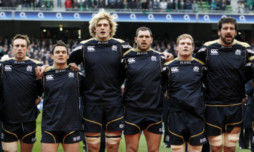
We need to get back our distinctive style and approach to the game.
Scott Johnson, Director of Rugby at the SRU, was in the Borders during the week talking to a group of coaches. Amongst other things, he was at pains to stress that Scottish rugby players weren’t the only ones that were passionate about playing for their country and he was quite right. Anyone representing their country should be full of pride and passion it’s not a ‘competitive advantage’ that Scots have over other teams, nor will it ever be.
But what Scott Johnson doesn’t appreciate is that Scotland used to have a distinctive style and approach to the game, which perhaps could sometimes be confused for passion. But now that seems to have been lost from the Scottish game.
Indeed, every country has its own style and approach which has perhaps been diluted in the professional game.
The French way was founded on a brutal pack who were technically supreme in the scrum, and a set of backs who were full of flair and pace. The All Blacks always played at a pace that few sides could compete with. England were proficient, but somewhat conventional, while the Welsh always had individuals who could win matches on their own.
Scotland’s game tended to revolve around an abrasive and competitive back row, coupled with half-backs who knew exactly how to get the best out of all of the players around them. It was sometimes manic and chaotic but it could be very effective the game was played at a pace and intensity and there was a never-say-die attitude. But that seems to have been lost in the modern era.
It doesn’t help that instead of nurturing and developing home-bred Scottish back row players, we’re hiring them in from abroad. Another one arrives in Edinburgh from New Zealand shortly.
But fundamentally, I wonder whether Scott Johnson really appreciates what the Scottish brand of rugby is like and therefore, how the professional teams should be developing accordingly. Andy Robinson got it when he was coaching at Edinburgh. They began to play a brand of rugby that was instantly recognisable as being Scottish. It has rarely been seen since. It wasn’t about passion, but about playing a game of continuity and pace and being unconventional.
That’s what has been lost by the international team, rather than passion, and from what Johnson was reported as saying, I’m not sure that he quite ‘gets it’.
If Johnson wants to really make a mark on Scottish rugby, this is where he should begin.

Enjoy the convenience of having The Sunday Post delivered as a digital ePaper straight to your smartphone, tablet or computer.
Subscribe for only £5.49 a month and enjoy all the benefits of the printed paper as a digital replica.
Subscribe